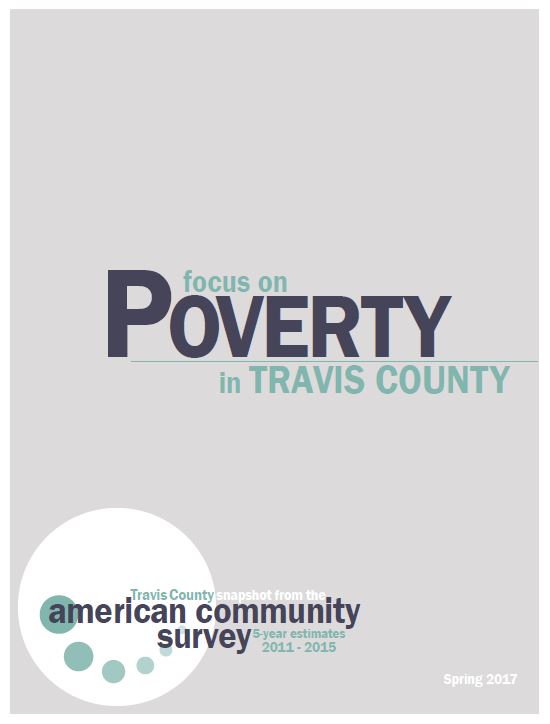
Travis County Research & Planning released an in-depth look at poverty in Travis County. The federal poverty threshold is about $12,000 in yearly income for a single individual and $24,250 for a family of four with two adults and two children. Since most social service agencies provide services to people at or below 200% of the federal poverty threshold, since research shows it takes at least that much to make ends meet in Austin, it is important to keep in mind that those living below the poverty level are thus living in extreme circumstances. According to this new analysis, more than 180,000 people in Travis County live in poverty – approximately 16% of the population.
The analysis by Travis County Research & Planning is based on American Community Survey 2011-2015 5-Year Estimates, which may differ slightly from the estimates on the CAN Community Dashboard based on American Community Survey 2015 1-Year Estimates. Because the 5-year estimates are the most reliable and provide the largest sample size, they allow researchers to explore characteristics of smaller populations with greater reliability, whereas the 1-Year Estimates provide the most current data available and a more nuanced look at trends over time.
Geographic Comparisons
Compared to the most populous counties in Texas, Travis County is the 5th most populous and has one of the lowest poverty rates. The counties with the lowest poverty rates also have the highest incomes: Collin, Travis, and Tarrant County. Similar patterns emerge when Travis County is compared to other Central Texas Counties: Travis County has one of the highest median family incomes and one of the lowest poverty rates.

Source: 2011-2015 American Community Survey 5-Year Estimates, B17001
Demographics
In Travis County, females have a higher poverty rate (18%) than males (15%) and the county’s overall poverty rate (16%). Children and young adults have poverty rates higher than Travis County’s overall poverty rate. Young adults aged 18-24 have the highest poverty rates (38%), followed by children under 18 years old (23%). Adults over 65 years old have the lowest poverty rates (8%).
In terms of race and Hispanic origin, Travis County researchers found that poverty rates are highest for residents who are Hispanic or Latino (26%) and Black or African American (23%). After analyzing the population of people living in poverty, however, researchers found that Hispanics make up a majority (55%) of those living in poverty, while comprising only 34% of the general population. In comparison, non-Hispanic Whites comprise 50% of the total population but only 27% of those in poverty.

Source: 2011-2015 American Community Survey 5-Year Estimates, B17001, B17001B, B17001C, B17001D, B17001E, B17001G, B17001H, B17001l
In our CAN Community Dashboard Poverty Drilldown, we report that 35% of Black or African American children and Hispanic children live below the federal poverty level, compared to 7% of Asian children and 6% of White children. When Travis County researchers looked at child poverty by race and Hispanic origin, a similar pattern emerged: researchers found the highest rates of child poverty to be among Hispanic or Latino children and Black or African American children. Hispanic or Latino children, although comprising 47% of the child population, make up 74% of children living in poverty, while Black or African American children, although comprising 9% of the child population, make up 14% of children living in poverty.

Source: 2011-2015 American Community Survey 5-Year Estimates, C18130
Individuals with disabilities were another group found to have high poverty rates compared to individuals without a disability, with 22% of individuals with a disability having incomes below the poverty level, compared to 16% of individuals without a disability. Children under age 18 with a disability have the highest rate of poverty (31%) within the disabled population.
CAN Community Council’s Focus on Child Poverty
This Supplemental Report is an excellent guide to help shed light on the issue of Poverty in Travis County, as it shows how poverty is, more than anything, a family problem that affects Hispanic and Black families especially. Part of CAN’s efforts to better understand this issue include making child poverty and other related issues the focus of the CAN Community Council’s agenda for 2017. We encourage you to explore the presentations in our Community Council meeting archive to learn more about child poverty in Travis County.
Source: Research & Planning Division, “Focus on Poverty in Travis County“, Travis County Health and Human Services, 2017